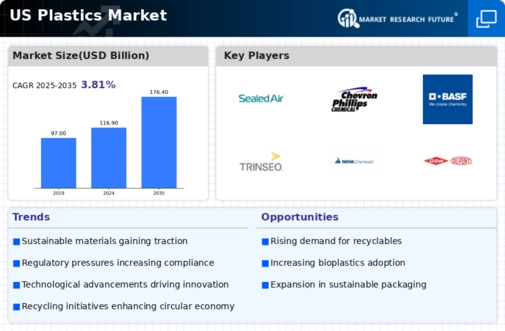The plastics market in the US is characterized by a competitive landscape that is increasingly shaped by innovation, sustainability, and strategic partnerships. Key players such as Dow Inc. (US), ExxonMobil Chemical (US), and LyondellBasell Industries (US) are actively pursuing strategies that emphasize technological advancements and eco-friendly practices. Dow Inc. (US) has focused on enhancing its product portfolio with sustainable materials, while ExxonMobil Chemical (US) is investing in advanced recycling technologies to reduce plastic waste. LyondellBasell Industries (US) appears to be concentrating on expanding its production capabilities to meet the growing demand for high-performance plastics, thereby reinforcing its market position.
In terms of business tactics, companies are increasingly localizing manufacturing to enhance supply chain efficiency and reduce lead times. The market structure is moderately fragmented, with a mix of large multinational corporations and smaller niche players. This fragmentation allows for a diverse range of products and innovations, although the influence of major players remains substantial in shaping market trends and standards.
In November 2025, Dow Inc. (US) announced a partnership with a leading technology firm to develop biodegradable plastics, which could significantly alter the competitive dynamics by appealing to environmentally conscious consumers. This strategic move not only enhances Dow's sustainability credentials but also positions it as a leader in the emerging biodegradable segment of the market. Similarly, in October 2025, ExxonMobil Chemical (US) unveiled a new facility dedicated to advanced recycling, which is expected to increase its capacity to process post-consumer plastics. This initiative underscores ExxonMobil's commitment to sustainability and its strategic pivot towards circular economy practices.
Moreover, in September 2025, LyondellBasell Industries (US) completed the acquisition of a smaller competitor specializing in specialty polymers. This acquisition is likely to bolster LyondellBasell's product offerings and market share, allowing it to better compete in high-value segments. The integration of this new entity is expected to enhance operational efficiencies and drive innovation in product development.
As of December 2025, the competitive trends in the plastics market are increasingly defined by digitalization, sustainability, and the integration of artificial intelligence (AI) in manufacturing processes. Strategic alliances are becoming more prevalent, as companies recognize the need to collaborate in order to innovate and meet regulatory demands. The shift from price-based competition to a focus on technological advancements and supply chain reliability is evident, suggesting that future competitive differentiation will hinge on the ability to innovate and adapt to changing consumer preferences and environmental standards.
























Leave a Comment